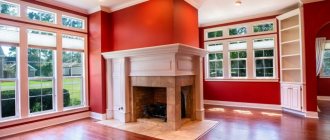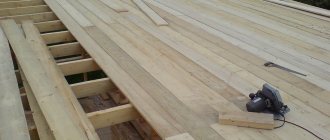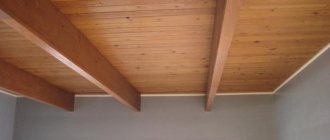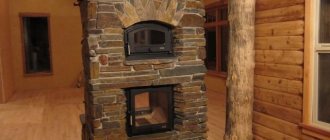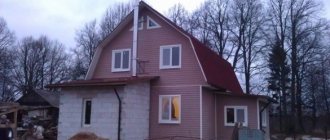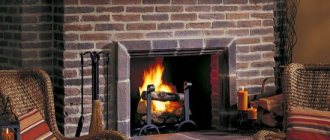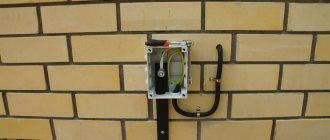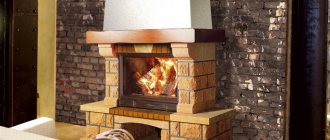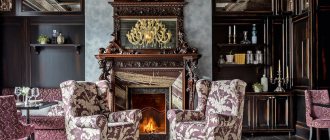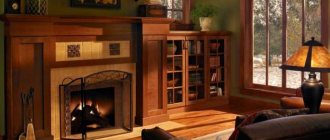Modern people get no less pleasure from contemplating living fire than their ancient ancestors. Apparently, genetic memory still exists. But in a cottage with all the amenities, and even more so in an apartment, it is difficult to set up a fireplace, and there is no need for it. But you can make a decorative fireplace from plasterboard that does not need a chimney. You can’t make a real fire in it, but there are many other ways to imitate a living flame and enjoy evenings of cozy family gatherings around the hearth.
A decorative portal with a built-in electric fireplace looks like a real one Source stihi.ru
Design
This is the very first stage, during which several important points should be taken into account, especially for functional fireboxes:
- It is necessary to determine the location for the equipment in the room relative to the walls and furniture arrangement. At the same time, do not forget about fire safety: the distance from flammable surfaces to the firebox is at least 700 mm.
- The base for the equipment is recommended to be made of concrete with a height of 300 mm. The perimeter of the foundation should extend beyond the dimensions of the firebox by 250 - 300 mm on each side.
- The recommended gap between the firebox and the plasterboard structure is 50 mm.
- An air vent box should be provided.
- Podium. The design must provide air flow for heating and support the weight of the firebox.
- The thickness of the fireproof wall finishing and a technical gap of 100 mm between it and the firebox.
- To accurately determine the dimensions of the portal, you should take into account the parameters of the facing material: profiles: guide – 27×28 mm and rack – 27×60 mm). For cladding, it is recommended to use fireproof or moisture-resistant plasterboard with a thickness of 12.5 mm.
- The design of the portal and its decoration should fit organically into the interior.
The listed parameters will help you avoid installation errors.
Video description
Try making a fireplace according to the instructions in this video or use it as an example to assemble your own design:
The instructions provided are suitable for simple wall-mounted models. Angular, asymmetrical and other complex shapes require an individual approach to frame assembly. Some craftsmen first make it completely, and only then fasten it in place.
It is important! When an electric fireplace is built into a plasterboard structure, the combustion chamber frame is assembled taking into account the fact that after plating its internal parameters will decrease.
Preparing the base
Considering that fireplaces are fire hazardous equipment, preparation of the floor and adjacent walls should be provided before covering the fireplace with fireproof plasterboard.
Floor preparation
The fireplace insert has a significant mass. Plus is equipment with an increased fire hazard. Therefore, at the first stage, a concrete base is prepared:
- The portal is marked on the floor.
- The formwork is being installed.
- The base is primed and filled with concrete.
- After hardening, a podium is laid out (4 rows of brickwork). Then install metal corners under the firebox.
- Lay the final level of masonry.
The whole process is carried out strictly according to the level. A misalignment of the foundation and podium will cause problems with the quality installation of the firebox.
Preparing the wall
The simplest option is when the adjacent wall is made of aerated concrete, foam concrete blocks or bricks. In this case, it is plastered and whitewashed. If the adjacent wall is made of flammable materials (logs, beams, etc.), then the following work is performed:
- Treating the wall with fire retardant compounds.
- Fastening a foil-coated basalt slab to a metal profile. A ventilation gap is required between the wall and the facing slab. The dimensions of the protective screen should be 500 - 600 mm larger than the dimensions of the future furnace.
- Fixing drywall, which is puttied, and clinker or porcelain tiles are laid on top.
Other options: asbestos board, magnesite. If the equipment will be installed in a corner, the joint between the walls is treated with a special fire-resistant sealant.
The same thermal insulation is also applied under the chimney. You should know that the gap from the fire-resistant wall to the rear surface of the firebox must be at least 100 mm, from the combustible surface - at least 700 mm.
Dream come true!
Layout
Work should begin with the manufacture of the box. We can safely say that this stage of work is the most important, because already at this stage the foundation, strength and stability of the future fireplace are laid. As a rule, the frame is made of UD and CD profiles. First, from a design drawn on a piece of paper, transfer the outline of the fireplace to the wall and partially to the floor. In this case, use a level, thereby achieving accuracy
Profile frame
When the entire frame is ready, you can begin covering it with plasterboard. After this, each formed joint is covered with a special putty.
If you want to make a footstool, you will need to additionally build a frame for it from a profile. Subsequently, logs can be placed on this foot as decoration.
Before installing an electric fireplace, you will need to thoroughly putty the entire structure. After grouting, the fireplace will be ready for finishing work.
Plasterboard cladding
It is not necessary to buy fireproof boards; you can also use moisture-resistant material. Cutting drywall parts is done using a simple paint knife. A cut is made along the marked line under any straight plank, after which the canvas is bent. The cardboard on the other side is trimmed.
When making a functional fireplace, the firebox and smoke exhaust box must be installed with thermal insulation and a foil reflector inside the device.
Do-it-yourself lining of a fireplace insert with plasterboard can cause difficulties in hard-to-reach places. And so the assembly technology is no different from any other gypsum board construction:
- The sheets are sewn to the profiles using metal screws. The hats go deeper into the canvas. It is better if individual parts are cut from a single sheet. This will make pre-finishing much easier. To process the corner joints of the structure, use a special plasterboard plane or a painting knife.
- For thermal insulation on the inside, the cladding is made using a basalt slab and foil. There is foil mineral wool. But attention should be paid to the quality of the glue used in this material. It must meet safety standards and withstand prolonged exposure to elevated temperatures.
The smoke exhaust box can also be made of plasterboard. Thermal insulation and foil reflector should be installed inside the device. The chimney box has holes for ventilation grilles.
How to do it yourself?
An electric fireplace is a good alternative to a conventional brick fireplace with real coals. If a real fireplace plays mainly the role of a heater, then an artificial fireplace primarily performs an aesthetic function.
To create a believable structure, in addition to decorative elements, you will need a strong frame. Real fireplaces are quite large, but to save space in the living room, this decorative element can be placed in the corner.
The interior must be made of metal to support the sheathing of drywall and other decorative elements. You will also need auxiliary tools: a screwdriver, self-tapping screws, a level, dowels, a grinder and a large knife.
To create a beautiful and reliable corner fireplace yourself, you definitely need to draw up a work plan and prepare everything you need.
Step-by-step instruction:
- Design on paper;
- Marking the area for the fireplace in the interior;
- Installation;
- Facing.
Finishing
For final cladding, the plasterboard base is prepared as follows:
- The screw caps are covered with putty. The composition should be selected for aggressive environments with elevated temperatures.
- After hardening, the excess is removed with a spatula or special masking paper/sandpaper.
- At the end, the surface is completely puttied, sanded, and primed. The plasterboard finish on the fireplace insert matched the finishing lining.
GCR is a universal material, so porcelain stoneware, gypsum, clinker tiles, natural stone and others can be used as a finishing coating. The finish is selected to match the style of the interior.
An interesting solution is porcelain stoneware. The modern market offers this tile with an imitation of any other finishing material - marble, granite, wood. Moreover, the canvases can also have a texture similar to natural fibers.
Finishing a fireplace with plasterboard with your own hands is a simple process, but it has a number of subtleties. False fireplaces do not require thermal insulation or a solid foundation. It’s enough to just build a plasterboard portal and choose the appropriate finish. In the case of functioning furnaces, it is recommended to contact professionals who will perform high-quality installation, which will ensure the reliability of the equipment and fire safety.
Useful tips from professionals
Construction of a box for a decorative portal requires patience and some skills; at the first stage, advice from professionals will be useful. The most interesting and artistic part of the work is the finishing of the front part.
The traditional way of decoration is wallpapering. Wallpaper hides surface unevenness well, and one layer of putty is enough. The wallpaper is selected to match the tone of the walls from one collection, using a border with an ornament to decorate the facade. The option of covering the box and walls with the same trellises looks good only in fashionable, stylish interiors - Scandinavian, minimalism, hi-tech. In this case, it is better to prefer monochromatic colors. A fireplace covered with floral wallpaper or with monograms looks out of place.
The influence of a plasterboard fireplace on the layout
At the same time, the decision to install a fireplace in your apartment should not be taken lightly. Wrong decisions will turn advantages into disadvantages, and an unnecessary pretentious shelf for trash and dust will be piled up in the corner. Therefore, we have prepared information on how to make a fireplace from plasterboard, in order to expand your design horizons.
First, you should carefully consider the changes in layout that the fireplace will cause and choose a suitable location. Based on your conclusions, think about the shape and appearance that you would like to see.
The simple design of plasterboard fireplaces reveals the limitless possibilities of this material. Don't get hung up on grave granite, the brick splendor of old England fences, or marble covered in bronze to look like gold. There are many other stylistic choices that can be fun to explore.
Simulated fire vs natural flame
The home comfort industry offers several options for simulating live fire with varying degrees of authenticity. From a full-fledged picture of a fire to an almost completely identical process of burning birch logs with smoke and flame. The dimensions and characteristics of the selected equipment will allow you to determine the dimensions of the plasterboard fireplace required for installation.
1 - electric fireplace; 2 — imitation of fire; 3 - portal decor
This is much better than the real soot, soot, firewood and drafts of a real fireplace. The question of choice is only the amount you are willing to pay for it and the goals you want to achieve. An electric fireplace, or combustion simulator, is that part of the structure that will have to be purchased ready-made. You won’t be able to make it yourself, and there’s no point in experimenting. But decorating an electric fireplace with your own hands will allow you to show creativity.
Start of installation work
The experience of using plasterboard in interior decoration can be expanded to interior elements. Making fireplaces of the desired appearance with your own hands is a completely feasible task. Make a drawing and put the main dimensions on it. Many people neglect this stage, making a big mistake at the very beginning of the matter. Three sets of work are conventionally distinguished:
- frame manufacturing
- covering the fireplace with plasterboard
- finishing
The frame can be assembled from a tin U- and L-shaped profile or from wood. It is difficult to say which is preferable; it all depends on the dominant skills of the performer. The advantage of tin can be considered that it allows you to easily reproduce a broken and even bent surface.
Work structure
Some stores provide ready-made portal layouts that do not require lengthy installation or repair work. However, such solutions are quite one-sided and do not allow imagination to unfold, contributing to the creation of a typical fireplace that is unlikely to please the eye. An alternative to buying angular and not very beautiful prefabricated structures is to build a full-fledged portal yourself. However, for this it is necessary not only to have some practical skills in working with materials, but also to have spatial thinking.
The structure of work to create such an object is as follows:
- preparatory work;
- collection of tools;
- construction of the frame;
- portal cladding;
- decoration.
The above steps are an integral part of constructing a portal with your own hands from plasterboard. Today, such a solution is one of the best, since it does not involve large material costs and does not require much time.
The key feature of construction work is preparation aimed at creating optimal conditions for the construction of the facility. In the case of our construction, it is based on the following:
- determining the location for installing the fireplace;
- clearing the area, preparing surfaces;
- creation of a basic construction plan.
We decide on the place where the portal will stand.
Based on these principles, building a full-fledged portal for an electric fireplace will not be difficult. At the very beginning, you should decide on the location of the fireplace system. Choosing it is not as difficult as when building a full-fledged stone fireplace, when it is necessary to strengthen the foundation and prepare a fire-resistant base, but still there are some nuances in this matter. The best place to install an electric fireplace is a wall in the back of the house or even a corner. In this case, the appearance of the fireplace will not be blocked by daylight, and the entire interior will become more cozy and comfortable.
This solution will create optimal prerequisites for the construction of the system, and will also make it possible to carry out construction work more quickly and accurately.
Drawings and their creation are an integral part of preparation. It is the creation of a plan that makes it clear what the finished object will be like, its geometric proportions and aspect ratios, as well as determine its shape and preferences for finishing.
We use a tin profile
Tin profiles are easily attached at intersections in one plane. The elements are connected using small self-tapping screws using a screwdriver or similar attachment on a drill or screwdriver. When making plaster fireplaces using tin profiles, evaluate your metal handling skills. Bends or breaks in the profile are made along the line of cuts in the side flanges. They should be made with an angle cutting machine with a metal cutting disk installed on it. You can use a jigsaw with a metal file.
All cuts are made in clearly marked places to ensure that the front side of the profile is bent or folded exactly in the required place. When assembling a fireplace from plasterboard with your own hands, you will have to stock up on tools for marking:
- square
- building level
- tape measure, construction ruler or laser tape measure
- construction marker for making marks and lines
The main requirement for the results of the work is that all surfaces must present a perfect plane.
Having completed the frame, we begin to create the surface. It is necessary to install sheets of drywall on the future fireplace. They are cut according to the configuration of the plane being closed. For pruning, you can use a construction knife, a hacksaw with fine teeth, or a cutting machine. The material cuts and breaks very easily. It is enough to draw a fault line and gently press along it along the loose side of the sheet. Drywall is attached to the frame with self-tapping screws, the length of which is about a centimeter greater than the thickness of the sheet and a diameter of about five millimeters.
After installing the sheets, you can putty the joints and seams using putty tape. This is not necessary if the surface is not subsequently painted or covered with film. Attention should be paid to careful alignment of the ends of the sheets facing intersecting planes. Do not forget that the lining of the fireplace insert with plasterboard should not be continuous, since electrical appliances installed in it need to remove heat. It is necessary to leave ventilation holes at the top of the structure.
What to paint with?
The more preferable method of finishing an artificial fireplace is painting. To do this, apply a primer to the rough layer of putty. After drying, a finishing putty is applied, which is rubbed with a fine mesh until a smooth, even top layer is obtained. Then comes another coat of primer for painting. The paint is applied in two or three layers, less often in one.
The modern generation of water-based acrylic paints have good technical characteristics, dry quickly, are odorless, and can be tinted to any desired shade. The acrylic paint coating is not afraid of moisture and can withstand several wet cleanings.
Oil-based paint is more resistant to external influences and temperature changes. When installing a fireplace with a heating element, you must choose a composition with a fire-resistant component. Interior acrylic paint is available in glossy and matte versions. Gloss gives a beautiful shine to the surface; if you use the marbled painting method, where beautiful stains are specially created, you need to choose this type of paint.
For classic fireplaces with stucco, it is better to opt for a matte structure; it gives a silky effect.
- Painting is a traditional way of finishing a stove or fireplace. With its help you can get any decor option, from artificial marble to a shiny metal surface. Bronze, gold, and silver components are used to give stucco a gilded effect. Pilasters, rosettes and moldings made of polyurethane foam are glued to the façade and painted white, green or blue. A gold stripe is applied to the carving of the pattern with a thin brush; it does not have to be perfectly smooth. Small changes in the width of the gilding will add an expensive handcrafted look to a classic palace-style fireplace.
- Portals made using the technique of “artificial aging of the surface” look very interesting. This decoration will decorate the interior in the style of shabby chic, loft, Provence. The technology of work is as follows. The first layer is painted with an active bright color. After drying, cover with pastel-colored paint. Next, you can apply one or more pastel layers of a different color. After waiting for complete drying, lightly rub the surface with sandpaper so that the lower layers of paint begin to show through. A vintage fireplace will take on the appearance of noble antiquity.
- It is worth paying attention to such painting techniques as applying patina and artificial cracks. Patina is a very thin layer of shiny gold, silver or bronze paint applied over the base color. Then the gilding is lightly rubbed down with sandpaper, creating the feeling of a very old valuable item. Artificial cracks - craquelure - are made by applying several different layers of color.
- On top, everything is covered with a special varnish, which cracks, lifting layers of paint behind it, resulting in a very interesting “antique” texture.
Fireplace assembly
Next we will consider the installation of a simple rectangular structure with a niche for an electrical screen.
Attention! The frame is mounted to the walls and floor on dowels - nails (in increments of 25-30 cm, be sure to fasten the edges of the elements), metal profile elements are fastened together with self-tapping screws - “fleas”.
Step 1: The work begins with markings, which should be done on the floor and walls of the room according to the prepared drawing - indicate the placement of all the elements that form the external frame and the contour of the “firebox”.
Step 2: Next, attach the profile cut to size to the wall (first vertical stripes, then horizontal), consistent with the markings of the external contour. Be sure to check the horizontal and vertical positions of the installed elements using a level and plumb line. The geometry of the structure must be strictly observed, otherwise the fireplace will “float” under load after cladding.
Step 3: The pieces that form the body of the fireplace are then attached to the floor. Elements perpendicular to the walls must rest with their ends against the profile fixed to the wall, and the profile located on the floor parallel to the wall. Check the geometry of the resulting floor structure and secure the profile to the floor.
Using the same principle, wall and floor sections of the profile for the frame of the combustion part are attached. Then, using a profile, the frame of the fireplace is formed. It is important to cut the profile taking into account allowances for the part that will be inserted into the supporting profile. During the work, be sure to check the geometry of the structure. If heavy cladding is expected, add lintels to stiffen the sheathing.
Step 4: Sheathing the sheathing. To cover the frame, parts are cut out of plasterboard sheet. Please note: if an electrical appliance is installed in the fireplace, it is necessary to pre-wire the power supply wire into the structure in a protective corrugated casing and provide an outlet. Cutting drywall. Markings are applied to gypsum board sheets. It is better to carry it out taking into account the actual parameters of the finished frame by taking measurements. It is convenient to cut drywall with a special saw, but you can also use a regular sharp mounting knife: the sheet is cut through to the bottom layer of cardboard, and then bent. Then, on the other side, the cardboard is cut along the fold line. It is advisable to chamfer the edges with a sharp knife (cut the edges of the cardboard layer at an angle of 45 degrees).
Step 6: Installation of cut fireplace elements: Elements from gypsum plasterboard are mounted on self-tapping screws, their heads should be slightly recessed into the cardboard. You should start with the outer skin. After completing this stage, we fix the bottom shelf and cover it with plasterboard. If the top element of the structure is a shelf made of boards, it is better to place the elements for fastening it from the inside, so this should be done before covering the frame.
Step 7: Insert and secure the screen. As a result, we should end up with something like this:
Next, it is best to putty the gypsum plasterboard structure. reinforce the corners with sickle tape and treat with a primer so that the finishing elements adhere well. Then you can start tiling the fireplace.
What can fireplaces be made of?
Today there is a huge amount of materials that can be used to build a fireplace in a country house. But there are exceptions to the rules and fireplaces can be found in the apartment. In a private house, a fireplace is built from:
These building materials are fireproof and can withstand high temperatures.
Advice. If brick is used in the construction of a fireplace, it should be red. It holds heat well and looks more aesthetically beautiful.
Materials used for construction:
- You can also use white brick. The decorative finishing of such a fireplace will be the decorative masonry of such building material. It can be made in different colors. To do this, special coloring substances are added to the concrete solution during the construction of the fireplace.
- If the fireplace is built from foam blocks or aerated concrete, then such material requires special finishing. They also hold heat well. Only when constructing a structure is it worth considering the large size of these building materials. It is for this reason that the fireplace can turn out to be quite large.
White brick fireplace
- Do not forget about chimneys from fireplaces, which are decorative in false structures; in real functioning fireplaces such a system is simply necessary. It helps remove combustion products. The chimney is usually made of brick. Its design must have a damper that ensures a sufficient supply of air masses into the fireplace for a better combustion process.
Making a drawing
The next stage is the creation of the project. In principle, there is no project here as such, you just need to sketch out a sketch in which the shape of the fireplace will be clearly visible. Don’t forget to put the dimensions of the future structure on paper. This will definitely come in handy when you have to transfer the dimensions into reality.
But here you will be faced with the question, what kind of fireplace do you want to see in your apartment? If you have not yet presented it, and you are having difficulties with this, then we recommend looking at photos of fireplaces in apartments, which are posted in large numbers on the Internet. At this stage, you just need to find the form option that suits you
Don't pay attention to the finishing, you'll deal with that later.
If the choice is made, then the form can be transferred to paper. Now align the dimensions of the portal with the dimensions of the room and the wall near which it will be built. Everything should be harmonious. Although there are no strict restrictions in this regard. You can make the fireplace high but narrow, or low but wide. The choice is huge, so go for it.
Construction technology
Fireplace insert
The firebox is the place where the combustion process of solid substances (coal or wood) directly occurs. Do-it-yourself finishing of the fireplace insert can be done:
- Plasterboard for finishing the fireplace insert is used only in the construction of false fireplaces. But, as a rule, there are exceptions to the rules. Drywall may be needed if the surface of the firebox needs to be leveled.
Advice. For such work, only a certain type of drywall is used - moisture resistant.
- During the work, it is worth noting that the size of the firebox may decrease. All this is due to the fact that drywall is attached to a metal frame. It is made on the surface from special profiles.
To install drywall, use:
- But here some difficulties may arise with the installation of the material. There are hard-to-reach places in the fireplace. It is for this reason that it is worth using a cordless screwdriver.
Drywall in the decoration of a false fireplace
- Finishing the fireplace insert with plasterboard can be used if it is necessary to significantly reduce the size of the firebox. This happens if the fireplace is quite large.
- When using drywall, it is necessary to initially consider the finishing inside in order to protect the material from the negative effects of fire.
For this you can use:
- A natural stone.
- Decorative rock.
- Ceramic tiles - in rare cases.
Finishing a fireplace insert with plasterboard will not be difficult. You can carry out the entire process of installing the material and then carry out the finishing work yourself.
Application of bricks
Brick lining of fireplace insert
As a rule, brick is used if the fireplace structure itself is built from this brick. In this case, the firebox is built together with the entire structure of the fireplace; such a firebox does not require additional finishing. Brick is also used when the entire structure of the fireplace is made of another material that cannot withstand temperature effects or is flammable. It could be:
- Tree.
- Drywall is not fire resistant.
The firebox and the chimney itself are built from it inside the structure. For safety, it is necessary to maintain a certain distance from the brick to the fireplace box. It should be at least 20-25 cm.
Using ceramic tiles
Ceramic tiles are rarely used for interior decoration of fireplace inserts. As a rule, it is glued to a flat surface. Most often on drywall. The installation is quite simple. In order to install ceramic tiles you must have:
Characteristics of ceramic tiles:
- Ceramic tiles are high-quality fire-resistant material. In order to carry out its high-quality installation, concrete mortar or special construction adhesive is used.
- To ensure that the distance between the tiles is uniform, it is necessary to use cross-shaped beacons that are inserted between each finishing element.
- After the installation of the tiles has already been carried out, a special product is used to mask the seams - decorative putty, which has a large selection of colors. Choosing a suitable option will not be difficult.
Design selection
Let's start with the fact that the first step is to establish in which place in the room the fireplace should be installed.
If you turn to a professional designer who is drawing up a design project for you, then this specialist will figure out where and what to install and how to place it.
But if you have taken on its role, then when creating the interior you will need to take into account some rules for installing a fireplace.
Everything will depend on the size of the room where it will be placed. If the room is small, then you can use two options: corner and in the form of a niche, slightly protruding from the wall.
The first option has several advantages:
- Small sizes.
- Does not take up useful space in the room.
- Fits well into the design.
- Can be used as a decorative shelf or cabinet.
The only negative is that the corner option cannot always be used. Usually the corners of the room near the window are covered with curtains, on the opposite side there is an entrance door in one corner, and on the other side the fireplace is not so clearly visible.
Therefore, it is best to give preference to the usual front element. Moreover, it is possible to build a small structure that will fit well into the interior of the room and will not take up much space.
This is interesting: Baroque style in the interior - undisguised luxury and wealth
External fireplace trim
Marble fireplace trim
Since fireplaces can be real or use electrical appliances that imitate a fireplace, the types of finishes can also be varied. Materials for finishing stoves and fireplaces:
Marble in the fireplace:
- For a fireplace, finishing with marble will be aesthetically beautiful. This gives the structure a rich look. The price for such material is quite high.
- As a rule, there is a ready-made marble lining for the fireplace. You can order it from specialists in the required size. You can assemble it yourself from separate parts. Finishing a fireplace with marble is a rather labor-intensive process and there are some nuances that you need to know.
- Marble is quite heavy and it is for this reason that it cannot be mounted on a plasterboard wall. But this rule does not apply to finished marble decorative elements.
- This finishing material is mounted only on a brick or any other stone surface. For this purpose, a special adhesive is used.
- agent or concrete solution with additives.
Some may argue about practicality, since the surface of such a finishing material is quite “capricious” and tolerates the effects of abrasive detergents. Spots may also appear on it over time, but this is only if the material is not properly processed. Drywall for finishing fireplaces:
- Finishing a fireplace with plasterboard is quite common. This type of finish for electric fireplaces is very popular.
- A frame is made based on the profiles. Sheets of drywall are already attached to it. Then they are plastered and finished.
- But here it is worth considering the point that the fireplace insert must also be made of plasterboard.
- Outside, a bassoon or decorative stone is used. These materials are very easily mounted on the surface of the material itself using special glue.
Porcelain tiles in finishing
Finishing the fireplace with a ceramic magnet
This finishing material began to be used in the decoration of fireplaces quite recently. It has excellent technical characteristics:
Finishing a fireplace with porcelain stoneware is quite popular:
- This finishing material is very easy to attach. The surface must be flat. For this, drywall or plaster is used.
- Porcelain tiles are mounted on the surface using special glue. Since the material is decorative, it does not have much weight. An example of the use of such material is shown.
Wood in the fireplace
The tree looks very beautiful. The wood trim of the fireplace can be represented by wooden lining. This material can be mounted on any surface. For installation you will need:
Wooden lining is used only for external work, as it is very flammable.
Advice. In order for the wooden lining to have a beautiful appearance and the material itself to serve for quite a long time, its surface must be varnished.
Glass in fireplace finishing works:
- Glass is used quite rarely in fireplace decoration. All this happens for the reason that it can burst under the influence of high temperatures. It is for this reason that special fired thermal glass is used to decorate the fireplace, which can withstand high temperatures and direct fire.
- Today, finishing fireplaces with glass can be used to decoratively cover the firebox or to make false fireplaces. Such designs look very original and unusual. They are able to decorate any interior and add zest to it.
As such, there are no instructions for making fireplaces with glass trim, but it is worth following certain rules and consulting with a specialist in this field before starting work.
Application of plaster
This surface decoration option has a lot of advantages, which include an affordable price and minimal time costs. Despite the visually simple composition of the material, it can be used to achieve an interesting pattern and surface design.
Advantages of this material
One of the most budget-friendly finishing methods. It has an affordable price with high quality coating at the output.
The plaster retains its original appearance for a long time; the surface does not crack or darken over time. Does not require special or complex care.
The material can be used both for decorative units and for devices in which a real flame burns in the hearth, or there is a heating element.
This design method allows you to profitably save not only effort, but also time, thanks to simple application and minimal drying interval.
Depending on the chosen application technique and the color of the plaster, the surface can be made either simply smooth or applied with any pattern - with a sponge, spatula or other tools and devices.
Plaster can be used for both decorative and wood-burning, electrical installations, depending on its fire resistance class and properties. Before using this material, you must read all the requirements and recommendations of the manufacturer (insert leaflet or instructions on the package).
You can learn more about examples of works decorated with this material by looking at the photos in this article.
What materials are used to make a plasterboard fireplace?
Drywall is not a fireproof material: it is not intended for use in contact with an open flame. Therefore, in the production of heating structures, you need to carefully select components. This will avoid a fire hazard. The sheets are divided into several groups according to their properties. For lining furnaces and use at high temperatures, fire-resistant products bearing the GKLO brand are better suited. Such materials are a sandwich product with an inner layer of gypsum and outer layers of cardboard impregnated with fire retardants. For visual differentiation, paper components are painted red or pink.
Buy thermal insulation boards in our catalog
The sheets are mounted on a metal frame constructed from a galvanized profile. It allows you to make a structure of any required configuration, based on the installation location, dimensions of the fireplace, and the desired final result. For better insulation of sheet building materials, a layer of insulation: basalt or fiberglass wool is placed in the space of the frame between the firebox and the cladding.
What kind of plasterboard fireplace to build?
For heating structures, the most rational choice is metal fireboxes. A wide selection of similar products, as well as their custom manufacturing, allow you to choose the best camera option. When choosing, they are guided by the estimated design of the device, the place and method of its installation, the type and size of the fireplace. You can purchase fireplace inserts from the options offered by manufacturers:
- Steel or cast iron;
- With internal lining with non-flammable heat-intensive materials (fireclay, refractory concrete, Aluker ceramics);
- Open and closed type;
- For wall mounting, recessed, corner placement;
- With panoramic glazing, with 1-3 sided glazing.
The safety of operating a fireplace with plasterboard cladding is at the forefront. Due to the nature of the sheet material, closed fireboxes with façade glazing are best suited for construction. Non-combustible materials are placed near the hearth: brick, stone, beautiful ceramic tiles, metal plate.
There are different methods of installing a fireplace, which determine the option of using plasterboard sheet:
- Portals made of plasterboard. This is an inexpensive way to decorate your fireplace beautifully. In this case, the wall near the firebox is lined with fireproof materials. A metal frame is attached to it. It can be simple rectangular, or made in a multi-level format, arched or column type. The sheets are cut to the required sizes. The blanks are used to sew up the frame, which forms the portal.
- Arrangement of a built-in fireplace in a plasterboard niche. A volumetric box is created from a metal profile. It provides space for installing a firebox. After completing the installation work, the frame is sewn up with gypsum plasterboard sheets. This method allows you to build a structure of the most unusual configurations - with asymmetrical placement, a wide-view firebox, in the form of a stove, etc. Such heating devices fit perfectly into modern interiors: art deco, cubism, hi-tech. Convection grilles can be installed in such structures. They provide improved air exchange and better heating of the room.
- Close accommodation. A frame with a niche for the firebox is made separately. The finished structure is installed in the selected location in the room and covered with plasterboard. This way you can install the device in the center of the room or corner.
When choosing a fireplace made of plasterboard, you can provide very useful details in the design: shelves, small niches for inserting decor, shaped holes, built-in lamps for original lighting, and more.
Methods for finishing plasterboard fireplaces
To give a plasterboard fireplace an aesthetic appearance, facing materials are used. Common finishing methods include:
- Coloring. Heat-resistant paints and varnishes are used. With their help, monolithic painting is carried out or a stencil, stylistic art drawing is applied.
- Ceramic tile. A simple way to make a device stand out from the overall interior. It is possible to use collectible tiles, ceramics with a glossy or matte texture, in any color tone or pattern.
- Stone cut. A successful way to decorate a fireplace that is visually no different from its luxury counterparts. The choice must be accompanied by qualified installation due to the possible large weight of the rocks used.
- Facing brick. Using facing bricks with a minimum thickness will allow you to imitate masonry. The finish from a cut of brick with a textured and colored front surface looks great.
- Plaster. A good option for finishing portal structures with a complex configuration, where the use of stone, tile, brick is difficult or impossible. Smooth or mineral plasters can be used to create a sparkling shine from a burning flame and make a plasterboard fireplace eye-catching and glaringly attractive.
Niche design options
The resulting portal also allows you to implement many interesting solutions:
- Installation of shelves. You can make removable or portable options.
- Placement of a painting or bas-relief. To achieve this, the space is made more open and the appropriate exterior decoration is selected.
- Illuminated glass insert device. To enhance the effect, a pattern is created on the base, which is illuminated in different shades.
- Installation of a mirror covering with decor in the form of electric candles.
The main thing is complete harmony with the style of the room; the fireplace should create an atmosphere of calm and set the mood for relaxation.
